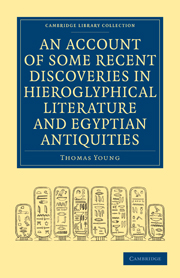 An Account of Some Recent Discoveries in Hieroglyphical Literature and Egyptian Antiquities
An Account of Some Recent Discoveries in Hieroglyphical Literature and Egyptian Antiquities Book contents
- Frontmatter
- Contents
- PREFACE
- WORKS OF THE AUTHOR
- CHAPTER I Introductory Sketch of the Prevalent Opinions respecting Hieroglyphics
- CHAPTER II Investigations founded on the Pillar of Rosetta
- CHAPTER III Additional Inferences, deduced from the Egyptian Manuscripts, and from other Monuments
- CHAPTER IV Collections of the French.—Mr. Drovetti.—Mr. Champollion's Discoveries
- CHAPTER V Illustrations of the Manuscripts brought from Egypt by Mr. Grey
- CHAPTER VI Extracts from Diodorus and Herodotus; relating to Mummies
- CHAPTER VII Extracts from Strabo; Alphabet of Champollion; Hieroglyphical and Enchorial Names
- CHAPTER VIII Chronological History of the Ptolemies, extracted from various Authors
- APPENDIX I Greek text of the Manuscripts and Registries
- APPENDIX II Specimens of Hieroglyphics
CHAPTER VII - Extracts from Strabo; Alphabet of Champollion; Hieroglyphical and Enchorial Names
Published online by Cambridge University Press: 01 March 2011
- Frontmatter
- Contents
- PREFACE
- WORKS OF THE AUTHOR
- CHAPTER I Introductory Sketch of the Prevalent Opinions respecting Hieroglyphics
- CHAPTER II Investigations founded on the Pillar of Rosetta
- CHAPTER III Additional Inferences, deduced from the Egyptian Manuscripts, and from other Monuments
- CHAPTER IV Collections of the French.—Mr. Drovetti.—Mr. Champollion's Discoveries
- CHAPTER V Illustrations of the Manuscripts brought from Egypt by Mr. Grey
- CHAPTER VI Extracts from Diodorus and Herodotus; relating to Mummies
- CHAPTER VII Extracts from Strabo; Alphabet of Champollion; Hieroglyphical and Enchorial Names
- CHAPTER VIII Chronological History of the Ptolemies, extracted from various Authors
- APPENDIX I Greek text of the Manuscripts and Registries
- APPENDIX II Specimens of Hieroglyphics
Summary
THE manner in which the Hieroglyphical alphabet was employed, in the time of the Roman emperors, may be understood from the examination of the specimens inserted in this chapter; they comprehend an example of each of the names and titles, which Mr. Champollion has included in his catalogue. In order to illustrate the veneration paid to the Roman emperors in Egypt, I shall subjoin an extract from Strabo, relating to the administration of that country, in the days of the earlier Caesars, for he was a contemporary and a subject of Tiberius.
Book XVII. “The whole of Egypt was divided into Nomes, the Thebaid containing ten, the Delta ten, and the intermediate parts sixteen, making in all 36. . The nomes were generally divided into Toparchiae, or local governments: and these again into other portions. . At Alexandria, the Necropolis is a separate suburb, containing gardens, and sepulchres, and subterraneous passages, employed for preserving the dead.
After the death of Julius Caesar, and after the battle of Philippi, Antony went into Asia, and paid extravagant honours to Cleopatra, even making her his wife, and having several children by her. He carried on, in concert with her, the war that was terminated at Actium, and accompanied her, as is well known, in her flight. Augustus following them, destroyed them both, and set Egypt at rest from the revels of a drunkard.[…]
- Type
- Chapter
- Information
- An Account of Some Recent Discoveries in Hieroglyphical Literature and Egyptian AntiquitiesIncluding the Author's Original Alphabet, as Extended by Mr. Champollion, with a Translation of Five Unpublished Greek and Egyptian Manuscripts, pp. 116 - 129Publisher: Cambridge University PressPrint publication year: 2010First published in: 1823


